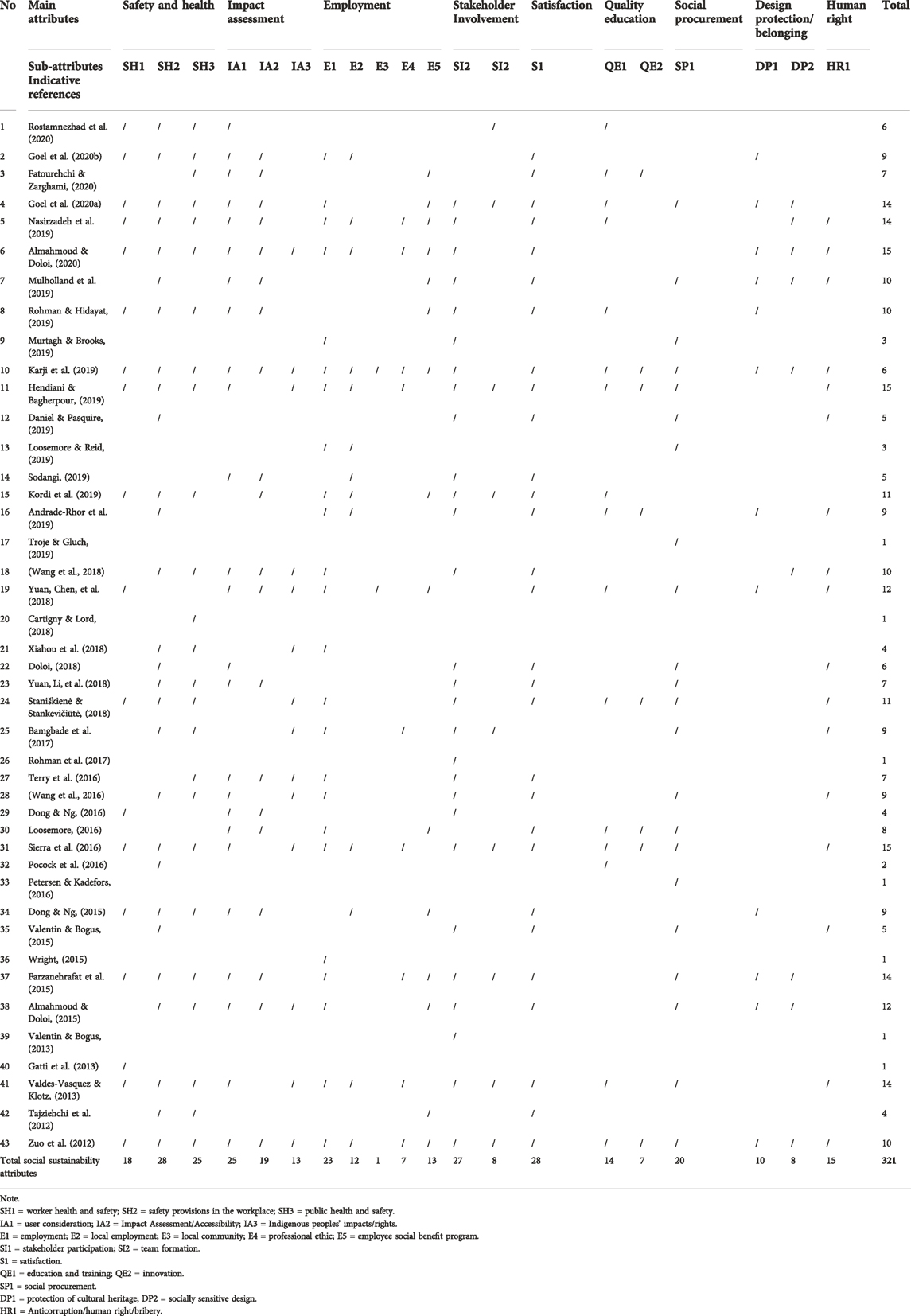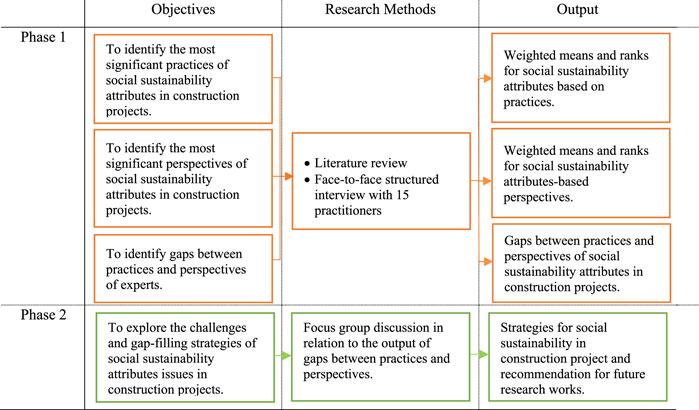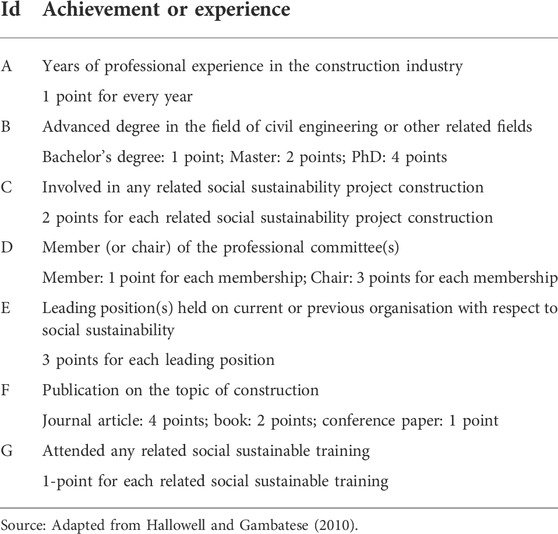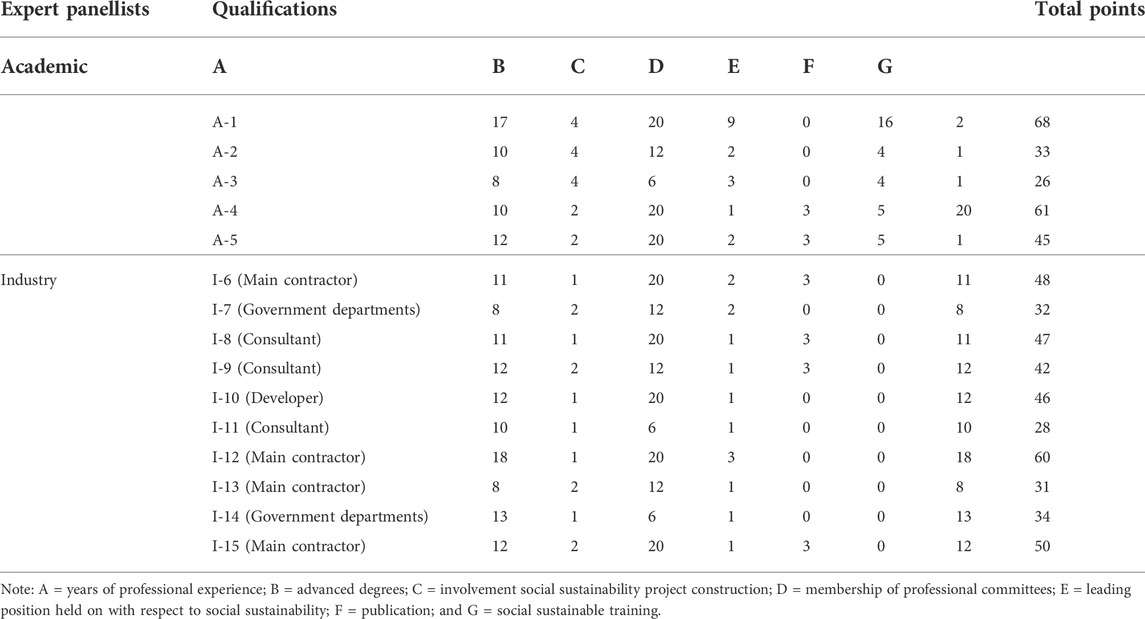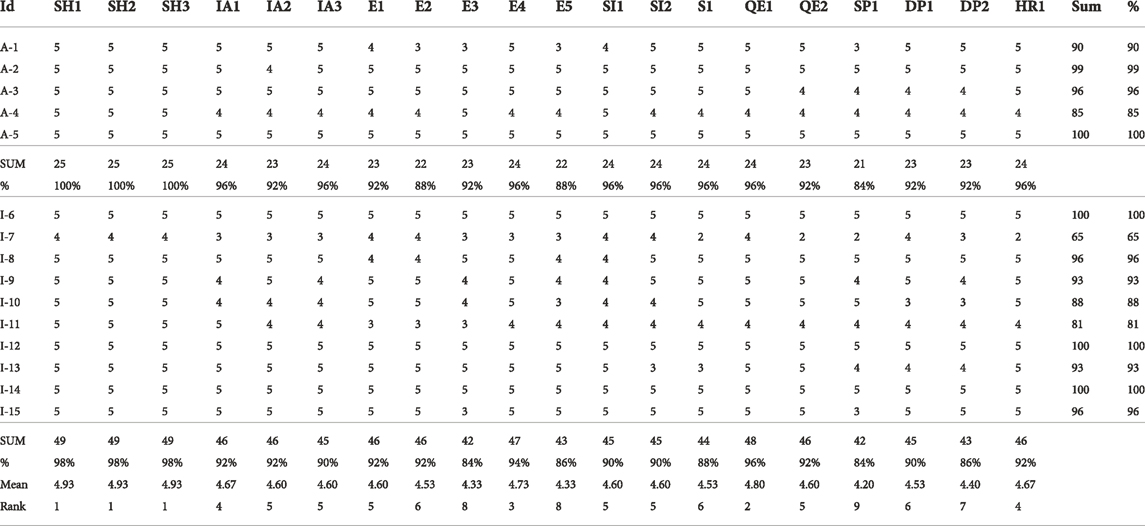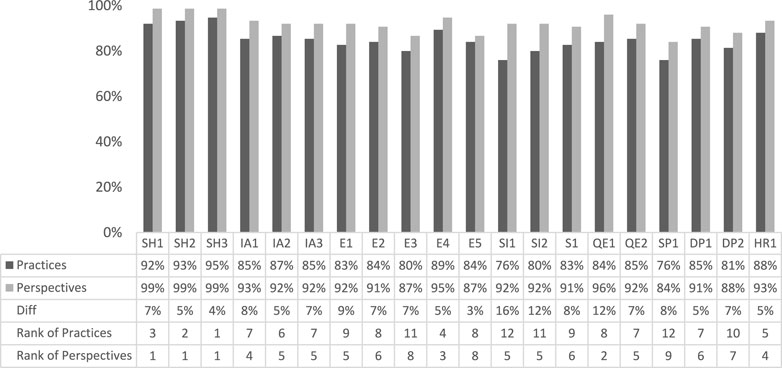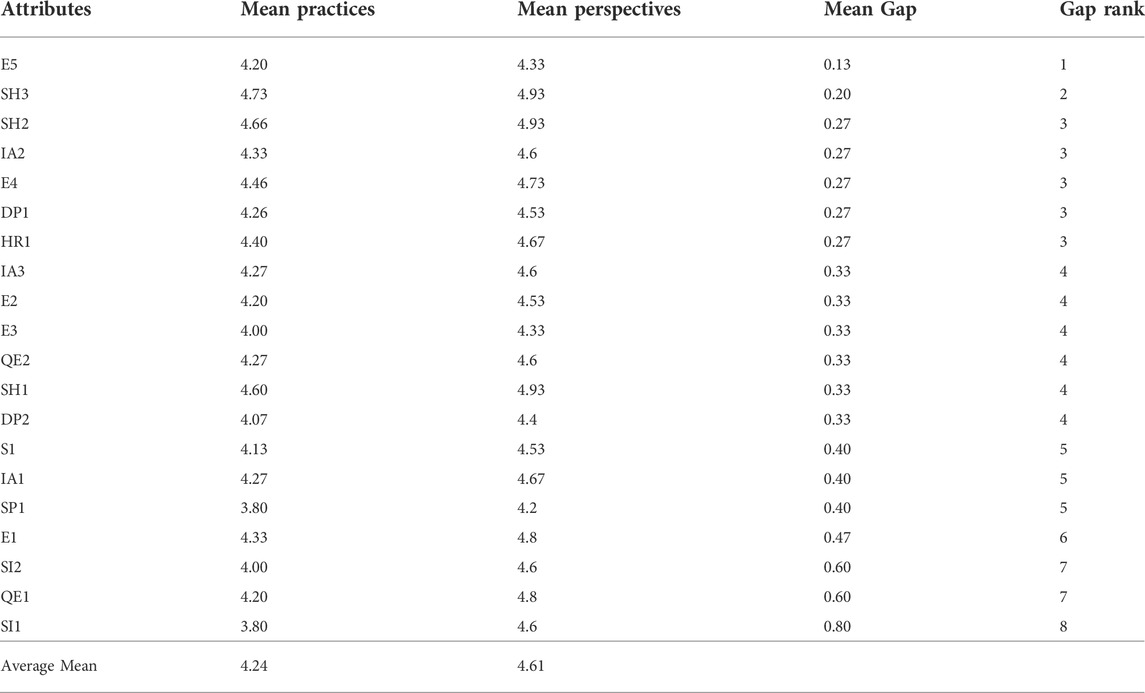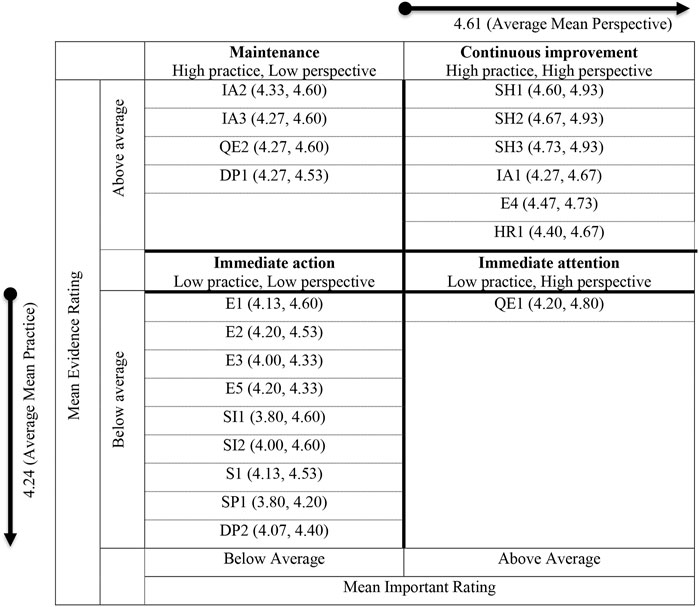- School of Civil Engineering, College of Engineering, Universiti Teknologi MARA, Shah Alam, Selangor, Malaysia
Past studies have recommended integrating social sustainability in the construction project to benefit a larger group of stakeholders. However, deeper insight into integrating social sustainability practices in the project remains elusive. Therefore, this study intends to address the knowledge gap by exploring the practices and perspectives of social sustainability in a construction project. The study first verified and confirmed the applicability of the social sustainability attributes adopted from the literature through structured face-to-face interviews with 15 practitioners. The practitioners have unanimously agreed that the social sustainability attributes could be categorized into nine 9) main components, namely: 1) safety and health; 2) impact assessment; 3) employment; 4) stakeholder involvement; 5) satisfaction; 6) quality education; 7) social procurement; 8) design protection/belonging; and 9) human right along with the 20 sub-attributes. The practitioners have further ranked the importance of the attributes based on real practices (experience) in their project and their professional opinion (perception). The greatest gap between the perception and practices was attributed to stakeholder involvement, indicating the need for additional effort to proactively engage stakeholders throughout the construction process. Further investigation through the gap and quadrant analyses highlighted that the education and training attribute requires immediate attention to ensure social sustainability could be practiced due to its perceived importance. This study has two major contributions: 1) provided a holistic view of the real practices against the perceived importance of social sustainability in construction projects; 2) established the gap between perception and practices of social sustainability, subsequently highlighting the strategic way forward to narrow the gap.
1 Introduction
In 1987, the World Commission on Environment and Development defined sustainable development as “meeting the needs of the present without compromising the ability of future generations to meet their needs” (Brundtland, 1987). Silvius and Schipper (2016) indicated in their research (systematic literature review) that 86% of the publications have addressed sustainable development in terms of the triple bottom line (TBL) based on the integration of environmental, economic, and social dimensions. Apart from the academic community, sustainable development has become the central element of the international agenda, particularly the Sustainable Development Goals (SDGs) formulated by the United Nations under its Agenda 2030 (Xie et al., 2021). Governments worldwide have agreed to a wide range of commitments and targets for actions to be taken towards addressing the 17 sustainable development goals.
Sustainable development consists of various activities across different industry sectors. Sustainable development is known as “sustainable construction”. However, over the last 20 years, sustainability in construction has focused more on the environmental and economic dimensions of sustainability, with the least concern given to the social sustainability (SS) aspect (Karakhan et al., 2020). There is a lack of a holistic approach to embedded SS attributes in creating sustainable construction projects (Li et al., 2021). It remains a gap in the current literature and practice (Stanitsas et al., 2021). In achieving the targets of SDGs, sustainable construction should accommodate all the sustainability pillars, including social, to improve the Gross Domestic Product (GDP) performance of the construction industry (Leje et al., 2020). Overlooking one of the TBL in construction, particularly SS attributes, can lead to inequities in people’s well-being (good quality of life), including security, health, and access to basic needs (Zuo et al., 2012). Thus, it is crucial for SS to be understood and further applied in practice, ensuring the incorporation and consideration of social aspects in construction.
Early research has revealed a dearth of data on the actual practices of SS that creates difficulty in measuring the performance of SS implementation in construction for improvements, particularly when comparing between the real practices of SS and the targets (attributes). Instead, most of the developed attributes were based on the design intent rather than actual performance (Whitfield, 2015). The lack of studies distinguishing the differences between the reality (on-site practices) and planned measures of SS (attributes) will impact the social aspect of a project (Sutrisna & Goulding, 2019). According to the practitioners’ perspective, SS attributes are important to be practiced in real construction project (Gurmu et al., 2022); however, there is gap between the perception and reality. Wide gap between the reality and perception of SS is associated with the lacking in SS practices, as opposed to the thoughts of it being important. Without proper gap analysis, practitioners might be working to improve SS attributes with the smallest gap, without realizing the need to narrow down the SS attributes with wider gap. Our curiosity was further motivated by the different SS dimensions and conceptions that could conceivably come into play, forming the basis for performance evaluation and the development of improvement strategies. Also, the increasing level of awareness on SS is becoming evident in the agendas for measuring the performance of SS in the real practice of construction project. Therefore, there is a need to respond to the real and ideal state of SS implementation by attaining the industry’s perspectives and practices towards creating a socially viable industry. A holistic view of the real practices against the perceived importance of SS in construction projects is particularly highlighted, further uncovering the gaps and way forward in narrowing down the gaps.
2 The attributes of social sustainability in construction
Social sustainability is generally understood as improving people’s well-being and quality of life (Mulholland et al., 2019). In order to facilitate the implementation of SS in construction projects, academic efforts were made to construct the knowledge base and the concept of SS itself. Scholars have established various SS attributes in order to measure project performance (Karji et al., 2019; Mulholland et al., 2019). Table 1 shows the summaries of nine main attributes of SS, together with 20 sub-attributes involving various construction projects. Most attention was given to Safety and Health followed by Impact Assessment, Employment, Stakeholder Involvement, Satisfaction, Quality Education, Social Procurement, Design Protection/Belonging, and Human Right.
The top main attribute, Safety and Health (S.H.), promises socially sustainable health and safety of workers (SH1) and public (SH3) by creating a safe, healthy, and comfortable environment. It also aims to predict possible catastrophic outcomes to mitigate risks for construction workers in the workplace (SH2).
The second most cited main attribute, Impact Assessment (I.A.), is about recognising a construction project’s impact on a community (IA1). The provision of impact mitigation plans is required to minimise disruptions to the people (IA2), caused by factors such as construction processes and project location in regard to public access/transit to public amenities (hospital, school, et cetera), in order to ensure convenience and efficiency to the people. Sub-attribute IA3 is about the rights and impacts of projects on the indigenous community, where potential disruptions from projects that could affect the life of the indigenous people should be avoided.
The third main attribute, Employment (E), aims to contribute new opportunities for employment (E1), local job availability (E2), employment of the vulnerable population, participation of small and medium enterprises, et cetera. The intention is to avoid conflicting issues between local and migrant workers (E3); therefore, the percentage of the locally hired workforce and the percentage of spending on the local-based supplier is included within this attribute. However, attribute E3 has the lowest number of mentions by scholars, indicating less attention was placed on this issue. The ethical aspects of the development of work (E4) and employee social benefit program (E5), including items such as company vehicles, allowances for lunch, paid cell phone, et cetera, are mainly significant under the main attributes of Employment.
The fourth main attribute, Stakeholder’s Involvement (S.I.), aims to enhance internal and external stakeholders’ involvement in the process of decision-making (SI1) and to inject the feeling of satisfaction through their positive contribution in team formation (SI2). The fifth main attribute, Satisfaction (S), is essential in ensuring workers’ and publics’ health conformance to the quality of the product (S1). The sixth main attribute, Quality Education (Q.E.), aims to improve the workforce’s skills by ensuring inclusive and equitable quality education and promoting lifelong learning opportunities (QE1), and by creating more innovative technical solutions (QE2) towards better performance and enhanced productivity among the employees as a lesson learnt from the project. The seventh main attribute, Social Procurement (S.P.), is by obtaining materials and equipment from manufacturers and suppliers who implement sustainable practices to intentionally create leverage social benefits and create social value in local communities (SP1). The eighth main attribute, Design Protection/Belonging (D.P.), aims to protect culture heritages (DP1) and to create additional design features that instil pride in the ownership among the users and the surrounding community, community acceptance, the next generation of stakeholders, as well as disabled people (DP2). The last main attribute is Human Rights (H.R.), which considers human rights violations such as child labour, forced labour, freedom of association, and collective bargaining (HR1). All of the attributes should be considered and forms the basis for future policy development in regard to social sustainability in construction.
2.1 The practices against the perspectives of social sustainability in construction
Many scholars have dived into the attributes of SS (Karji et al., 2019; Kordi et al., 2021) and evaluation of the attributes through various case studies or projects (Gatti et al., 2013). However, limited studies were found in the context of perceptions, real practices and strategies of SS in construction projects. In a recent study, Fatourehchi & Zarghami (2020) have developed a SS assessment framework that addresses SS criteria in residential buildings in Iran. However, a holistic approach on the subsequent steps, which is strategies to improve the SS attainment from the evaluation of the real practices, has been less emphasised. Similarly, Alipour and Galal Ahmed (2021) and Karji et al. (2019) have established a set of sustainability attributes to assess the effects of SS for urban neighbourhoods in Dubai. Nonetheless, there were no suggestions, particularly from the expert respondents, to improve the state of SS in the investigated projects. Even though SS is deemed important at the policy level, there is little knowledge on how the policies are disseminated, implemented, and embedded in the daily practices of construction professionals worldwide.
3 Methodology
The research methodology for this study is provided in Figure 1. This study involves two major phases in addressing the four objectives of this study. The research methods involved pilot test, structured interviews, and focus group discussion (FGD).
3.1 Phase 1-questionnaire development and gap analysis
The SS attributes’ terms for questionnaire survey development used in this study were adapted from literature review (LR). After several rounds of discussion with the relevant industry experts, the terms used in this study were finalized with consensual acceptance by the industry experts. The questionnaire survey is divided into two sections. The first section is the demographic of participants. Participants need to provide general information, experiences, and involvement in SS construction projects. In the second section, participants need to evaluate each of the SS attributes, as established in Table 1. The evaluations are divided into two; 1) SS attributes considered or applied in the project (based on real project experiences), and 2) the importance (based on perception) of SS attributes to be embedded in projects towards sustainable construction. Numerous studies have demonstrated that the Likert five-point scale can be used to improve the quality and speed of responses, while also minimizing ambiguity in responses (Ekanayake & Ofori, 2004). Additionally, research utilising five-point scale surveys have demonstrated higher reliability coefficients (Sarvari et al., 2021), resulting the use of five-point Likert-scale in this study. Rating scales of 1, 2, 3, 4, and five represented “definitely no”, “probably no”, “unsure”, “probably yes”, and “definitely yes” respectively for real project experiences; and “very little importance”, “little importance”, “moderately important”, “important”, and “very important”, respectively for perception.
3.1.1 Face-to-face structured interview
Face-to-face structured interviews were considered appropriate to validate the applicability of SS attributes obtained from the LR and solicit their views in greater depth regarding the embedment of SS attributes in construction projects. This is to ensure the researchers could interact more thoroughly with the participants (Creswell & Creswell, 2017). In order to achieve a detailed and comprehensive evaluation on the status quo of SS practices in the construction project, this paper has solicited input from all concerned practitioners, including developers, contractors, consultants, owners, and educational entities. The practitioners have been purposively selected based on their affiliated organisation. The organisation they represent should have prior experience in SS-based projects to gauge the relevant knowledge and experience regarding SS. The qualification of practitioners was assessed based on the point system (Table 2) proposed by Hallowell and Gambatese (2010) to meet a minimum level of qualification. It was suggested that the expert’s profile must fulfil a minimum of four requirements from a list of ten proposed and a minimum of 11 total points to guarantee the rigour of the method. A pilot test and rounds of discussion have been made to ensure consensus and acceptance were obtained among the industry practitioners.
Different researchers have recommended different expert panel sizes to optimise the interview sessions. As Hallowell and Gambatese (2010) suggested, at least eight to 12 expert participants are good for interview sessions to confirm on any construction research indicators. Yin and Caldas (2020), Jafari et al. (2019), Tsolakis et al. (2019), and Loosemore (2016) utilised 12, 11, 14, and 12 experts, respectively, for their interviews with expert panels. Therefore, this study has also used the same range of participants, while the purposive sampling method was used to select eligible participants based on their experience and expertise. Five academic and ten panels from the industry were purposely selected and invited to participate in the structured interviews as expert panellists. Including both industry professionals and academics provides assurance that the findings from this study would have practical and theoretical implications. Moreover, the inclusion of experts from different fields of study could minimise potential biases toward one or more of the attributes (Karakhan et al., 2020).
3.1.2 Data analysis
The data analysis was performed to explore and understand differences in the attributes, rank of importance, investigate on the correlations, gaps between practices and perspectives, and uncover the underlying social attributes. Attributes with a high average value were ranked as high priority, leading to SS attributes that should be embedded in construction projects. Attributes with a low average value were ranked as low priority. Also, from the performance of reality and perspectives were strategies to close the gap. All items and the total score of both the reality and perspectives showed high internal consistency (with Cronbach’s alphas of 0.964 and 0.948, respectively).
Gap analysis is concerned with comparing the actual practice and desired perspective. This was used in this study to calculate and compare the differences in the mean of practices and perspectives of SS attributes in construction projects. Quadrant analysis was further used to identify and assess the variables. According to Oke et al. (2019), a quadrant plot, which is the basis of quadrant analysis, is a measure of importance vs. performance (perspective vs. practice) and usually shows key areas for improvement. The perspective-practice quadrant analysis was carried out to integrate the rankings of current perspective and practice levels of social sustainability attribute to identify areas for improvement and further development.
3.2 Phase 2-gap-filling strategies
Phase 2 of the study involves revisiting the respondents by sharing the findings of the gaps between practices and perspectives. FGD was conducted with same expert panels to gauge their opinion and perception of the findings and to further brainstorm on strategies to fill the gap between SS perception and practices in construction projects. FGD is a qualitative research approach used to incorporate the diverse perspectives from numerous stakeholders on a specific topic (Hallowell & Gambatese, 2010). This technique was founded to foster interactive discussions and information sharing among a group of experts to produce new ideas and knowledge, defining a consistent and holistic perspective on a subject matter (Montalbán-Domingo et al., 2021). The method is particularly useful when objective data is unattainable, lack of empirical evidence or when the heterogeneity of the participants must be preserved to assure the validity of the results (Hallowell & Gambatese, 2010).
FGD was used to elicit opinions using various processes and controls. Anonymity, multiple rounds, and controlled feedback are among the controls used during data collection and analysis techniques to reduce cognitive and social biases that threaten the validity and reliability of the results (Bhandari & Hallowell, 2021). The research methodology and the protocol of the FGD used in this study was consistent with the suggestions from Morgan, (1997).
4 Findings and discussion
4.1 Profiling of respondents
Table 3 shows the qualification of the 15 identified expert panels. All of the respondents have scored greater than 11 points and were qualified as expert panels (Hallowell & Gambatese, 2010). Nonetheless, it is worth highlighting that the expert panels' total points were significantly higher than the 11-point threshold. All experts have received more than 20 points, with the majority scoring 30 points or more, indicating their capability, competencies, expertise, and credential in assessing the SS attributes for this study. Although there are differences between the academics and industry professionals in academic publications and practical experiences, such variances could be well-justified. The nature and expectations of an academic job differ from an industry job; hence, differences are expected, especially on the publication and training score. According to Di Cesare et al. (2018), developing a social assessment framework needs to be associated with the affected parties. In this case, academicians were also the affected parties (end-users) even though they were not directly involved in construction projects. Importantly, all the participants had previous construction experiences and were aware of the sustainability practices that their respective organisations have implemented. In addition, the researchers believe that the experts' different levels of research and industry experiences is one of the strengths of the present study.
From the overall sample, 80% of the respondents had more than 10 years of professional experience in the construction industry, including two experts with over 15 years of experience. There were five experts from the academics and ten from the construction industry. The respondents’ backgrounds were diverse, including one expert was a senior manager, seven were project managers, and two were engineers from the industry respondents.
4.2 The practices of social sustainability attributes in construction projects
This section discusses on the responses in regards to SS practices and the relevant real project experiences. The experts have first unanimously agreed that the SS attributes could be divided into nine main components and twenty sub-attributes, as shown in Section 2. Based on those attributes, Table 4 shows the level of implementation on real projects, as rated by the experts. As a result, the Safety and Health category showed the highest level of application in projects, alongside the sub-attributes in this category that were given the highest rank. Public health and safety (SH3) were the attribute considered most by practitioners in projects, followed by safety provisions in the workplace (SH2) and worker health and safety (SH1). The findings highlight positive initiatives among construction organisations as health and safety have been the priority in projects.
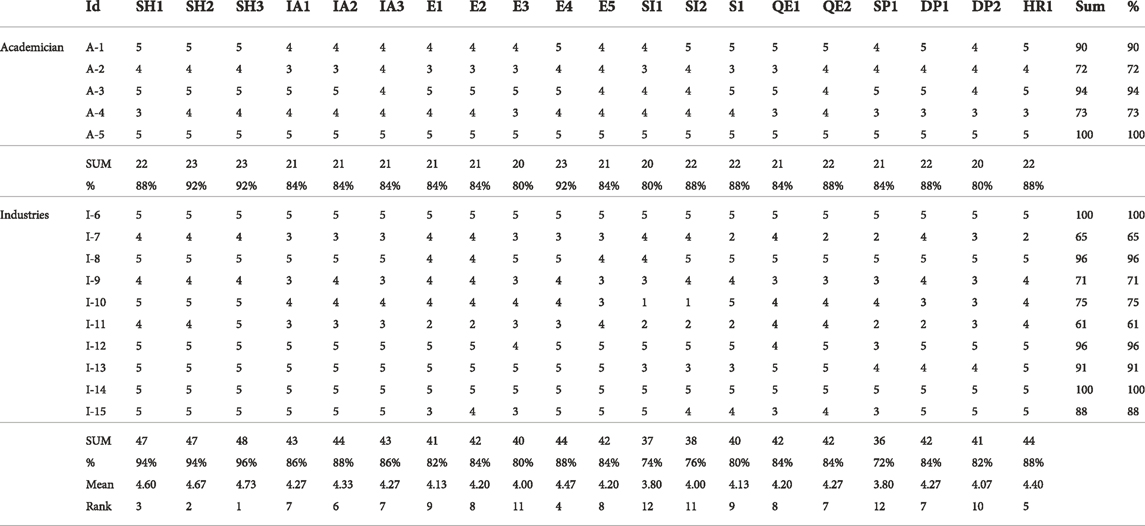
TABLE 4. Weighted Means and Ranks for Social Sustainability Attributes based on Real Project Experience.
Conversely, stakeholder participation (SI1) and social procurement (SP1) were the least implemented attributes in projects. Generally, SI1 is vital in the communications and decision-making process, whilst SP1 is essential towards leveraging social benefits in creating social value among the local communities (Watts et al., 2019). Both attributes require the involvement of various parties in order to establish mutual understanding in decision making. However, the constraint often lies in the differing expectations and requirements of multiple stakeholders that could be diverse and conflicting.
4.3 The perspectives of Social sustainability attributes in construction projects
This section highlights the experts’ opinions and perspectives of SS attributes in construction projects (Table 5). Safety and Health (SH) was rated the most important attribute as all experts have rated ‶5″ for all the sub-attributes under this category. Only one expert (I-7) from the industry gave ‶4″. This is in line with findings from the literature (Refer Table 1), where SH was found to be the most dominant attribute. García de Soto et al. (2019) stated that the construction industry has one of the worst safety and health records. Therefore, the SH category is highly prioritised in construction projects due to workforce health and safety involvement, the influx of migrant workers, and the impact on communities and livelihoods. Subsequently, Education and Training (QE1) was perceived to be the second-highest important sub-attributes that should be considered in construction projects. In this regard, attention is given to obtaining and maintaining professional licensing/certification for lifelong learning opportunities and improving the workforce skills in technical and sustainability.
The third ranked sub-attribute, Professional Ethic (E4) considers ethical aspects such as gender diversity, staff recruitment and professionalism towards enhancing workforce integrity. This is only achievable if the organisation has a fully operationalised policy on integrity.
Ranked fourth were User Consideration (IA1) and Human Rights (HR1). IA1 is the provision of site plan with minimal disruption with improved community access; meanwhile, HR1 was the understanding of human rights policies or procedures to ensure the compliance with human rights, social and labour law obligations.
The fifth ranked sub-attributes were IA2, IA3, E1, SI1, SI2, and QE2. The attributes share the same rank with a mean score of 4.60. The sixth sub-attributes were E2, S1, and DP1, with a mean of 4.53. DP2 was ranked seventh-; E3 and E5 were ranked eighth; and Social Procurement (SP1) was the least important attribute to be considered in the construction project with a mean of 4.20.
4.4 The gap between the practices and perspectives of social sustainability
A gap analysis was conducted to explore the perception and real practices of the SS attributes in construction projects. Findings from a gap analysis could assist in identifying specific areas for improvements, subsequently enabling the establishment of actionable steps to improve the current practices in moving towards the ideal state. In this study, the gap analysis was conducted between the findings in Section 4.2 (Practices) and Section 4.3 (Perceptions), as shown in Figure 2.
A paired-samples t-test was conducted to compare between the SS practices and perspectives. There was a significant difference between the practices (M = 4.24) and perspective (M = 4.61), where t (19) = 2.093 and p = 0.000. In general, the percentages for perspectives are higher than practices, which translates into a higher awareness on the importance of SS as compared to its implementation. The results revealed that Stakeholder Participation (SI1) has the biggest gap (16%) between real project experiences and perspectives, followed by Team Formation (SI2) and Education and Training (QE1), both with a 12% gap. The analysis reveals that these sub-attributes require attention; thus would be the highlight of the following content. Meanwhile, gaps for the other attributes were less than 10%, showcasing high level of implementation alongside the perceived importance of the SS attributes.
From the comparison analysis, SI1 was ranked fifth in regards to its perceived importance, while the attribute was ranked last in real project experience. The differences are high (16%), showing the lack of emphasis on stakeholders’ participation in projects. The participation of stakeholders in construction projects might elicit innovative ideas and sustainable solutions from various perspectives; therefore, the collaboration between the project team with other stakeholders at all stages of the project life cycle is vital for decision making towards social sustainability. An effective stakeholder participation programme that includes the public can benefit both parties (decision-makers and the public) in a variety of ways (Naderpajouh et al., 2012).
There is a need to have design and construction team that focuses on sustainability, to ensure the project includes the elements of SS (SI2). An organisation may select a team with an academic qualification related to sustainability, experience, and knowledge in SS projects and able to implement tasks following the sustainable guideline. The large gap for SI2 of (12%) is supported by Bakar et al. (2018) that the construction industry lacks qualified and capable design teams associated with SS projects because it can increase the cost for a project. In Malaysia, for example, there is no existing rule to include SS in projects thus, lacking government support with no incentives for sustainable construction projects (Bakar et al., 2018).
Also, education and training are essential for improving workforce skills in technical and sustainability terms, leading further to educating the community (QE1). The gap shows the lack of emphasis on enhancing workforce skills and the community with life-long learning initiatives, regardless of the perceived importance. In line with Che Ibrahim et al. (2021), there is a dearth of specific trainings in the civil engineering programmes. The findings indicated that incorporating health and safety programs in the curriculum by cooperating with the industry to get their input may have advantages in providing early safety education for future engineers. Training or courses should also be attended throughout the working life, instead of only during the undergraduate education (Toole et al., 2017).
Meanwhile, in regards to the gaps of less than 10% between the perspectives and practices, sub-attributes of “Worker Health and Safety” (SH1), “Safety Provisions in the Workplace” (SH2), and “Public Health and Safety” (SH3) have the gaps of 7%, 5%, and 4% respectively, and were ranked first for both, the perspectives and practices. This indicates that the main attribute of S.H. is highly influential for the aspect of SS in construction projects. The others sub-attributes with less than 10% gap are: E1 (gap value of 9%); IA1, S1, SP1 (8%); IA3, E2, E3, QE2, and DP2 (7%); IA2, E4, E4, and HR1 (5%); and the least gap sub-attribute is E5 (3%). It is worth highlighting that the percentage of perceptions for the sub-attributes are higher than the percentage of practices. This indicates that effort should be made to improve the implementation of these sub-attributes, to align with the thoughts.
4.5 Perspective-practice quadrant analysis
Gap and quadrant analyses were employed to create a decision hierarchy in narrowing the gap between the perspective and practice of SS in construction. This approach encourages the understanding of interfaces between the attributes, setting of priorities, and deciding on specific techniques (Oke et al., 2019) for achieving SS in construction. Figure 3 presents the perspective-practice quadrant analysis plot. The y-axis represents the mean values of the perspective of SS attributes in the construction project, while the x-axis represents the mean values of the practices. The plots are represented with the code and mean values listed in Table 6. The average mean for the level of perspectives and practice are 4.61 and 4.24, respectively. All plots before the mean 4.61 falls below average under the perspective’s axis and 4.24 for the practice’s. Based on the variables plotted in Figure 3 and the average mean and rank of variables in Table 6 and Figure 4 indicates the perspectives-practices quadrant analysis. The analysis shown in the lower right-hand quadrant is the attributes that require immediate attention for the profession to sustain its present relevance. In contrast, those at the upper right-hand quadrant are attributes that need continuous improvement. The figures in brackets are the practices and perspectives’ mean of variables. The lower left-hand quadrant is below average in both perspective and practice and needs immediate action. A total of seven attributes were rated above average and deemed important, while 13 were rated below average.
The perspective-practice quadrant analysis reveals that the areas of attributes that require immediate attention are education and training (QE1). The inadequate QE1 in construction project causes the industry to suffer from the lack of sustainability talent. This can be overcome by holding short and long-term courses depending on the requirements of personnel. The organisation may take a radical approach by introducing sustainability training programs such as Sustainable Construction and Development, as developed by CIOB and London South Bank University (CIOB Academy, 2020). Similar approaches can be seen in previous studies-e.g., in New Zealand (Sajjad & Shahbaz, 2020) and in the United States (Suh et al., 2016), where sustainability training programs could result in improved sustainable construction initiatives. However, as noted by Lim et al. (2015), accreditation bodies need to alert on the importance and the urgency in the development of SS education as currently, the sustainability topics embedded in courses only covers fundamental sustainability categories, which are more focused on environmental and economic issues (Alipour & Galal Ahmed, 2021).
There are also needs for immediate actions to be taken for attributes E1, E2, E3, E5, SI1, SI2, S1, SP1, and DP2 as these attributes were rated below average in both perspective and practice (lower left-hand quadrant). Stakeholder involvement (SI1) has the highest difference of mean (0.8) between perspective and practice and considered as attribute that requires the most immediate action in the construction project. One of the proactive strategies an organisation can adopt is by establishing collaborations between the project team and other stakeholders at all stages of project life cycle. Construction companies can also improve their prospects by choosing team members (SI2) based on academic qualifications related to sustainability with the capability of handling SS projects (Marzouk & Sabbah, 2021). Four out of five (E1, E2, E3, and E5) attributes from the Employment category falls under this quadrant. These attributes can turn into strength as these attributes enables generation of new employment opportunities, job stability, employment of the vulnerable population, and participation from small and medium enterprises (Shen et al., 2007). Therefore, the government has to support and stimulate sustainable growth and development, including improvements in job growth, capacity building, productivity, business attractiveness, and liveability that will boost these attributes (Dudzai, 2018). Also, by having a standard policy of social procurement (SP1) with the inclusion of socially sensitive design (DP2) and social criteria in tendering documents, the project will be a success for sustainable outcomes such as a benefits for the disadvantaged group (Montalbán-Domingo et al., 2019) and enhanced satisfaction of the product’s quality (S1).
The attributes of SH1, SH2, SH3, IA1, E4, and HR1 require continuous improvement. Even though the attributes were balanced on the high quartile, in regards to the perception and relevant practices, the improvements still need to be built on. The other remaining social sustainability attributes at the top left-side quadrant are IA2, IA3, QE2, and DP1 where the mean gaps are between 0.27 and 0.33 and are considered good and to be maintained.
After establishing the quadrant in Figure 4, an open-ended interview session was held with the expert panels from Phase 2. The expert panels were shown the quadrant (in Figure 4) in order to attain their thoughts and input on the attributes and how those attributes relate to the current practices and perspectives. The following section highlights the responses gathered regarding the critical attributes that need immediate attention.
4.6 The way forward
All attributes mentioned in this study are important to be considered. However, paying the same attention to all of the SS attributes is impossible and can be impractical. Therefore, decision-makers need to pay attention to priority weight to meet the objectives of SS. In this study, QE1 is the priority attribute that needs immediate attention. The discussion from the open-ended interview is presented below by listing the challenges and gap-filling strategies of QE1 issues in construction projects. Some literatures are used to substantiate the selective quotes from the interview session.
Our results align with Martin and Root (2012), where construction industries lack in providing training and relevant experiences among the workforce, especially at the construction stage.
“…lack of workforce skills in technical and sustainability terms. SS is not a priority in the project and normally are not included in the contract.”—Project Manager.
“…organisation is more focused on finishing the job scope on time rather than giving opportunities to strengthen workers’ skills. Some novices obtain their skills through “learning by doing” and some by apprenticing senior co-workers.”- Senior Manager.
“… by sending workers to attend training/course will cause shortage of workers and organisation needs to pay for the cost. Workers are unwilling to pay the additional cost to attend the training. Furthermore, if workers go for course/training by their own initiative, they need to take unpaid leave.”- Project Manager.
“…project does not have a specific annual fund for continuing education or attending professional development and education programs. It is dependent on the yearly budget.”- Project Manager.
“…project does not have a guideline principle on human resource development and does not sponsor the workforce in obtaining professional licensing and certification.”- Director of Facility Management.
It is demotivating for employees as there would not be any increase in their salaries though they have improved their skills. Training and refresh courses should be made mandatory for workers because the minimal theoretical and operative skillset of construction workers is considered one of the principal reasons behind the poor performance in quality and safety (Wang et al., 2019).
“…education is essential for the growth of human capital, knowledge, and skills. The more education construction workers have, the greater their appreciation for knowledge and expertise.”- Senior Lecturer.
Therefore, there is need for personal and collective continuous development through workshops, conferences, and seminars that will benefit the organisations responsible for the profession’s regulation in their pursuit of improved job performance. It is also necessary to train students and retrain practising engineers to instill competencies (Oke et al., 2019). Thus, construction managers or policymakers can take some corresponding incentives to drive workers to engage in training programs to achieve sustainability in construction. In summary, we propose the following suggestions have been proposed to improve the current state of training in the construction industry, particularly to address attribute QE1.
• Developing health and safety programs or training modules through academic-industry collaborations.
• Providing continuous educational training courses with effective mechanism for training certification and compensation. Suggested to match the income and benefits with the appropriate level of certificate. Salary is determined by the training/course certificate of the employee, not by the employer’s will. By consensus, the only method to enhance salary and benefits is for workers to earn a higher training certificate after they have polished their abilities and complete the required training courses.
• Establishing requirement in the contract that requires at least 50% of the construction managers, engineers, supervisors, and other personnel within the organisation to have valid professional license or certificate (e.g., Ir., IOW, SHO, PMP, CIDB green card, et cetera). This requirement will ensure the employees are capable and aligned with the needs of the construction industry.
• Better funding or incentive by government/accreditation bodies to assist the development of social sustainability.
5 Conclusion
Social sustainability studies are growing globally, advocating for more responsible decisions to be taken towards sustainable construction, not without room for improvements. Hence, this paper has focused on identifying the most prominent gap between the perception and practices of SS in construction projects. Structured interviews with 15 experts have first verified the 20 social sustainability attributes from the literature, which was further ranked based on the practices and perspectives, subsequently highlighting the gap and possible way forward to improve the status-quo of social sustainability in construction. The findings indicate that the concept of SS is not something new to most of the respondents. However, the gap between real project experiences and perspectives still exists. The quadrant analysis has resulted in appropriate strategies based on the average mean of SS attributes. The analysis shows that education and training (QE1) is the attribute that requires immediate attention that sought for continuous educational training courses. The biggest gap is stakeholder involvement (SI1) which highlights the need for more effort to be placed in proactively engaging with stakeholders throughout all stages of construction.
5.1 Implications
There are several implications to be drawn from this study. This study offers a holistic picture on the importance versus implementation of SS attributes, further exacerbating the gap and way forward from the current state. The findings from this study have implications for both the practitioners and researchers. For practitioners, the results point to deficiencies in the current incorporation of SS in projects that require attention or further actions to ensure better involvement of SS across the project. For scholars, this study contributes to SS research by verifying the attributes needed to socially sustain the construction project activities. Such evidence would enhance the argument for incorporating SS concerns into construction projects. The developed quadrant will provide both academics and practitioners a shared language to make sense of the overall picture of priorities (perceived and practiced) for SS in construction projects.
5.2 Limitations and future directions
Even though efforts have been made to ensure the meticulousness of this study, some limitations would still need to be acknowledged. First, the methodological approach has a limitation in undertaking a total of 15 interviews among Malaysian construction players, based on purposive sampling, which implies that the generalizability of the findings can be limited. Second, most interviewees hold senior management positions or work for large organizations. As a result, their perspectives may not reflect stakeholders of different positions nor smaller organizations. Thus, future studies can solicit perspectives from other disciplines, such as civil and mechanical engineers, industrial engineers, and safety professionals. Nevertheless, this study has established an useful starting point in objectifying the attributes of SS, subsequently empowering the often side-lined social values in construction projects.
Data availability statement
The raw data supporting the conclusions of this article will be made available by the authors, without undue reservation.
Ethics statement
The studies involving human participants were reviewed and approved by REC/11/2020 (MR397). The participants provided their written informed consent to participate in this study.
Author contributions
All authors listed have made a substantial, direct, and intellectual contribution to the work and approved it for publication.
Funding
This work described in this paper has been co-funded by a Geran Penyelidikan Khas (GPK) [Ref no: 600-RMC/GPK 5/3 (220/2020)] from Universiti Teknologi MARA.
Acknowledgments
The authors are grateful to the Universiti Teknologi MARA [Project 600-RMC/GPK 5/3 (220/2020)].
Conflict of interest
The authors declare that the research was conducted in the absence of any commercial or financial relationships that could be construed as a potential conflict of interest.
Publisher’s note
All claims expressed in this article are solely those of the authors and do not necessarily represent those of their affiliated organizations, or those of the publisher, the editors and the reviewers. Any product that may be evaluated in this article, or claim that may be made by its manufacturer, is not guaranteed or endorsed by the publisher.
References
Alipour, S. M. H., and Galal Ahmed, K. (2021). Assessing the effect of urban form on social sustainability: A proposed ‘integrated measuring tools method’ for urban neighborhoods in Dubai. City territ. Archit. 8 (1), 1. doi:10.1186/s40410-020-00129-4
Almahmoud, E., and Doloi, H. K. (2015). Assessment of social sustainability in construction projects using social network analysis. Facilities 33 (3–4), 152–176. doi:10.1108/F-05-2013-0042
Almahmoud, E., and Doloi, H. K. (2020). Identifying the key factors in construction projects that a ff ect neighbourhood social sustainability. F. 38, 765–782. doi:10.1108/F-11-2019-0121
Andrade-Rhor, D., Montalbán-Domingo, L., Garcia-Segura, T., and Pellicer, E. (2019). Social and environmental sustainability rating systems and certification programs. ISEC 2019 - 10th Int. Struct. Eng. Constr. Conf. 1–6.doi:10.14455/ISEC.res.2019.155
Bakar, N. F. S. A., Ismail, S., Amat, R. C., and Durdyev, S. (2018). Sustainable construction in Malaysian mixed development projects: The barriers and critical success factors. J. Soc. Sci. Res. 2018, 885–892. Special Is). doi:10.32861/jssr.spi6.885.892
Bamgbade, J. A., Kamaruddeen, A. M., and Nawi, M. N. M. (2017). Malaysian construction firms’ social sustainability via organizational innovativeness and government support: The mediating role of market culture. J. Clean. Prod. 154, 114–124. doi:10.1016/j.jclepro.2017.03.187
Bhandari, S., and Hallowell, M. R. (2021). Identifying and controlling biases in expert-opinion research: Guidelines for variations of delphi, nominal group technique, and focus groups. J. Manage. Eng. 37 (3), 04021015. doi:10.1061/(asce)me.1943-5479.0000909
Brundtland, G. H. (1987). Oslo: Our Common Future.Report of the world commission on environment and development
Cartigny, T., and Lord, W. (2018). Evaluating social value in the UK construction industry. Proc. Institution Civ. Eng. - Manag. Procure. Law 172 (1), 8–16. doi:10.1680/jmapl.17.00051
Che Ibrahim, C. K. I., Belayutham, S., and Mohammad, M. Z. (2021). Prevention through design (PtD) education for future civil engineers in Malaysia: Current state, challenges, and way forward. J. Civ. Eng. Educ. 147 (1), 05020007. doi:10.1061/(asce)ei.2643-9115.0000030
Ciob Academy, (2020). Sustainable construction and development. London WC2B 6XF, United Kingdom: CIOB Academy. https://www.ciobacademy.org/product/sustainable-construction-and-development/.
Creswell, J. W., and Creswell, J. D. (2017). Research design: Qualitative, quantitative, and mixed methods approaches. Thousand Oaks, California, USA: Sage publications.
Daniel, E., and Pasquire, C. (2019). Creating social value within the delivery of construction projects: The role of lean approach. Eng. Constr. Archit. Manag. 23 (2), 1105–1128. doi:10.1108/ECAM-06-2017-0096
Di Cesare, S., Silveri, F., Sala, S., and Petti, L. (2018). Positive impacts in social life cycle assessment: State of the art and the way forward. Int. J. Life Cycle Assess. 23 (3), 406–421. doi:10.1007/s11367-016-1169-7
Doloi, H. (2018). Community-centric model for evaluating social value in projects. J. Constr. Eng. Manag. 144 (5), 04018019. doi:10.1061/(ASCE)CO.1943-7862.0001473
Dong, Y. H., and Ng, S. T. (2016). A modeling framework to evaluate sustainability of building construction based on LCSA. Int. J. Life Cycle Assess. 21 (4), 555–568. doi:10.1007/s11367-016-1044-6
Dong, Y. H., and Ng, S. T. (2015). A social life cycle assessment model for building construction in Hong Kong. Int. J. Life Cycle Assess. 20 (8), 1166–1180. doi:10.1007/s11367-015-0908-5
Dudzai, C. (2018). The value of social sustainability policies to poverty reduction in Zimbabwe: A social work perspective. Afr. J. Soc. Work.
Ekanayake, L. L., and Ofori, G. (2004). Building waste assessment score: Design-based tool. Build. Environ. 39 (7), 851–861. doi:10.1016/j.buildenv.2004.01.007
Farzanehrafat, M., Akbarnezhad, A., and Ghoddousi, P. (2015). “Analysis of different views towards social sustainability in construction,” in Proceedings of the 32nd ISARC, Oulu, Finland, September 2015.
Fatourehchi, D., and Zarghami, E. (2020). Social sustainability assessment framework for managing sustainable construction in residential buildings. J. Build. Eng. 32, 101761. doi:10.1016/j.jobe.2020.101761
García de Soto, B., Agustí-Juan, I., Joss, S., and Hunhevicz, J. (2019). Implications of Construction 4.0 to the workforce and organizational structures. Int. J. Constr. Manag. 0 (0), 205–217. doi:10.1080/15623599.2019.1616414
Gatti, U., Migliaccio, G., Bogus, S. M., Priyadarshini, S., and Scharrer, A. (2013). Using workforce’s physiological strain monitoring to enhance social sustainability of construction. J. Archit. Eng. 19 (3), 179–185. doi:10.1061/(ASCE)AE.1943-5568.0000110
Goel, A., Ganesh, L. S., and Kaur, A. (2020a). Project management for social good: A conceptual framework and research agenda for socially sustainable construction project management. Int. J. Manag. Proj. Bus. 13 (4), 695–726. doi:10.1108/IJMPB-06-2019-0155
Goel, A., Ganesh, L. S., and Kaur, A. (2020b). Social sustainability considerations in construction project feasibility study: A stakeholder salience perspective. Eng. Constr. Archit. Manag. 27 (7), 1429–1459. doi:10.1108/ECAM-06-2019-0319
Gurmu, A., Shooshtarian, S., Mahmood, M. N., Hosseini, M. R., Shreshta, A., and Martek, I. (2022). The state of play regarding the social sustainability of the construction industry: A systematic review. J. Hous. Built Environ. 37 (2), 595–624. doi:10.1007/s10901-022-09941-5
Hallowell, M. R., and Gambatese, J. A. (2010). Qualitative research: Application of the delphi method to CEM research. J. Constr. Eng. Manag. 136 (1), 99–107. doi:10.1061/(ASCE)CO.1943-7862.0000137
Hendiani, S., and Bagherpour, M. (2019). Developing an integrated index to assess social sustainability in construction industry using fuzzy logic. J. Clean. Prod. 230, 647–662. doi:10.1016/j.jclepro.2019.05.055
Jafari, A., Valentin, V., and Bogus, S. M. (2019). Identification of social sustainability criteria in building energy retrofit projects. J. Constr. Eng. Manag. 145 (2), 1–11. doi:10.1061/(ASCE)CO.1943-7862.0001610
Karakhan, A. A., Gambatese, J., and Simmons, D. R. (2020). Development of assessment tool for workforce sustainability. J. Constr. Eng. Manag. 146 (4), 04020017. doi:10.1061/(asce)co.1943-7862.0001794
Karji, A., Woldesenbet, A., Khanzadi, M., and Tafazzoli, M. (2019). Assessment of social sustainability indicators in mass housing construction: A case study of mehr housing project. Sustain. Cities Soc. 50, 101697. doi:10.1016/j.scs.2019.101697
Kordi, N. E., Belayutham, S., and Che Ibrahim, C. K. I. (2021). Mapping of social sustainability attributes to stakeholders’ involvement in construction project life cycle. Constr. Manag. Econ. 39 (6), 513–532. doi:10.1080/01446193.2021.1923767
Kordi, N. E., Belayutham, S., Ibrahim, C. K. I. C., and Zulkifli, A. R. (2019). “The attributes of social sustainability in construction: A theoretical exploration,” in Proceedings of the 35th Annual ConferenceAssociation of Researchers in Construction Management, ARCOM 2019,Leeds, UK September 2019, 629–638.
Leje, M. I., Shamsulhadi, B., Fadhlin, A., and Muhammad-Jamil, A. (2020). Impacts of skilled workers on sustainable construction practices. Int. J. Sci. Technol. Res. 9 (3), 6699–6706.
Li, Y., Xiang, P., You, K., Guo, J., Liu, Z., and Ren, H. (2021). Identifying the key risk factors of mega infrastructure projects from an extended sustainable development perspective. Int. J. Environ. Res. Public Health 18 (14), 7515. doi:10.3390/ijerph18147515
Lim, Y. S., Xia, B., Skitmore, M., Gray, J., and Bridge, A. (2015). Education for sustainability in construction management curricula. Int. J. Constr. Manag. 15 (4), 321–331. doi:10.1080/15623599.2015.1066569
Loosemore, M., and Reid, S. (2019). The social procurement practices of tier-one construction contractors in Australia. Constr. Manag. Econ. 37 (4), 183–200. doi:10.1080/01446193.2018.1505048
Loosemore, M. (2016). Social procurement in UK construction projects. Int. J. Proj. Manag. 34 (2), 133–144. doi:10.1016/j.ijproman.2015.10.005
Martin, L., and Root, D. (2012). Profiling emerging contractors for effective transformation in the South African construction sector. Dev. South. Afr. 29 (2), 209–223. doi:10.1080/0376835X.2012.675693
Marzouk, M., and Sabbah, M. (2021). AHP-TOPSIS social sustainability approach for selecting supplier in construction supply chain. Clean. Environ. Syst. 2, 100034. doi:10.1016/j.cesys.2021.100034
Montalbán-Domingo, L., García-Segura, T., Sanz, M. A., Pellicer, E., and Asce, M. (2019). Social sustainability in delivery and procurement of public construction contracts. J. Manage. Eng. 35 (2), 1–11. doi:10.1061/(ASCE)ME.1943-5479.0000674
Montalbán-Domingo, L., Pellicer, E., García-Segura, T., and Sanz-Benlloch, A. (2021). An integrated method for the assessment of social sustainability in public-works procurement. Environ. Impact Assess. Rev. 89, 106581. doi:10.1016/j.eiar.2021.106581
Morgan, D. L. (1997). “Focus group as qualitative research,” in Qualittaive research method series. 2nd Editio (Thousand Oaks, California, USA: Sage Publications), 16.
Mulholland, C., Ejohwomu, O. A., and Chan, P. W. (2019). Spatial-temporal dynamics of social value: Lessons learnt from two UK nuclear decommissioning case studies. J. Clean. Prod. 237, 117677. doi:10.1016/j.jclepro.2019.117677
Murtagh, S. R., and Brooks, T. (2019). Critical success factors for social value in construction procurement in Northern Ireland. Proc. Institution Civ. Eng. - Manag. Procure. Law 172 (5), 183–196. doi:10.1680/jmapl.19.00005
Naderpajouh, N., Boppana, A., and Hastak, M. (2012). The need for indices to assess the health of the construction industry. Constr. Res. Congr. doi:10.1061/9780784412329.152
Nasirzadeh, F., Ghayoumian, M., Khanzadi, M., and Rostamnezhad Cherati, M. (2019). Modelling the social dimension of sustainable development using fuzzy cognitive maps. Int. J. Constr. Manag., 223–236. doi:10.1080/15623599.2018.1484847
Oke, A. E., Ogunsemi, D. R., and Adeyelu, M. (2019). Quadrant and gap analysis of required and exhibited quantity surveyors’ competencies. J. Eng. Des. Technol. 17 (6), 1161–1173. doi:10.1108/JEDT-01-2019-0029
Petersen, D., and Kadefors, A. (2016). “Social procurement and employment requirements in construction,” in Proceedings of the 32nd Annual ARCOM Conference, ARCOM 2016, Manchester, UK, September 2016.
Pocock, J., Steckler, C., and Hanzalova, B. (2016). Improving socially sustainable design and construction in developing countries. Procedia Eng. 145, 288–295. doi:10.1016/j.proeng.2016.04.076
Rohman, M. A., Doloi, H., and Heywood, C. A. (2017). Success criteria of toll road projects from a community societal perspective. Built Environ. Proj. Asset Manag. 7 (1), 32–44. doi:10.1108/BEPAM-12-2015-0073
Rohman, M. A., and Hidayat, Y. A. (2019). Understanding social sustainability criteria for public school building. IOP Conf. Ser. Mat. Sci. Eng. 636 (1), 012022. doi:10.1088/1757-899X/636/1/012022
Rostamnezhad, M., Nasirzadeh, F., Khanzadi, M., Jarban, M. J., and Ghayoumian, M. (2020). Modeling social sustainability in construction projects by integrating system dynamics and fuzzy-DEMATEL method: A case study of highway project. Eng. Constr. Archit. Manag. 27 (7), 1595–1618. doi:10.1108/ECAM-01-2018-0031
Sajjad, A., and Shahbaz, W. (2020). Mindfulness and social sustainability: An integrative review. Soc. Indic. Res. 150 (1), 73–94. doi:10.1007/s11205-020-02297-9
Sarvari, H., Nassereddine, H., Chan, D. W. M., Amirkhani, M., and Md Noor, N. (2021). Determining and assessing the significant barriers of transferring unfinished construction projects from the public sector to the private sector in Iran. Constr. Innov. 21 (4), 592–607. doi:10.1108/CI-07-2020-0112
Shen, L. Y., Li Hao, J., Tam, V. W. Y., and Yao, H. (2007). A checklist for assessing sustainability performance of construction projects. J. Civ. Eng. Manag. 13, 273–281. doi:10.3846/13923730.2007.9636447
Sierra, L. A., Pellicer, E., and Yepes, V. (2016). Social sustainability in the lifecycle of Chilean public infrastructure. J. Constr. Eng. Manag. 142 (5), 05015020. doi:10.1061/(ASCE)CO.1943-7862.0001099
Silvius, A. J. G., and Schipper, R. P. J. (2016). Sustainability in project management: A literature review and impact analysis. Soc. Bus. 4 (1), 63–96. doi:10.1362/204440814x13948909253866
Sodangi, M. (2019). Social sustainability efficacy of construction projects in the pre-construction phase. Proc. Institution Civ. Eng. - Eng. Sustain. 172 (2), 57–67. doi:10.1680/jensu.17.00057
Staniškienė, E., and Stankevičiūtė, Ž. (2018). Social sustainability measurement framework: The case of employee perspective in a CSR-committed organisation. J. Clean. Prod. 188, 708–719. doi:10.1016/j.jclepro.2018.03.269
Stanitsas, M., Kirytopoulos, K., and Leopoulos, V. (2021). Integrating sustainability indicators into project management: The case of construction industry. J. Clean. Prod. 279, 123774. doi:10.1016/j.jclepro.2020.123774
Suh, M. J., Pearce, A. R., Yildiz, F., and Jeon, M. H. (2016). “Training and education for green construction in the U.S,” in Proceedings of the 2016 ASEE Annual Conference & Exposition.New Orleans, Louisiana June 2016, doi:10.18260/p.27070
Sutrisna, M., and Goulding, J. (2019). Managing information flow and design processes to reduce design risks in offsite construction projects. Eng. Constr. Archit. Manag. 26, 267–284. doi:10.1108/ECAM-11-2017-0250
Tajziehchi, S., Monavari, S. M., and Karbassi, A. (2012). An effective participatory-based method for dam social impact assessment. Pol. J. Environ. Stud. 21 (6), 1841–1848.
Terry, H. Y. L., Ng, S. T., Skitmore, M., and Li, N. (2016). Investigating stakeholder concerns during public participation. Proc. Institution Civ. Eng. - Munic. Eng. 169, 199–219. doi:10.1680/jmuen.15.00018
Toole, T. M., Gambatese, J. A., and Abowitz, D. A. (2017). Owners’ role in facilitating prevention through design. J. Prof. Issues Eng. Educ. Pract. 143 (1), 1–9. doi:10.1061/(ASCE)EI.1943-5541.0000295
Troje, D., and Gluch, P. (2019). “Social procurement in the real world: How employment requirements unfold in construction projects,” in Proceedings of the 35th Annual Conference Association of Researchers in Construction Management ARCOM 2019, September 2019,Leeds, UK 24–33.
Tsolakis, N., Bam, W., Srai, J. S., and Kumar, M. (2019). Renewable chemical feedstock supply network design: The case of terpenes. J. Clean. Prod. 222, 802–822. doi:10.1016/j.jclepro.2019.02.108
Valdes-Vasquez, R., and Klotz, L. E. (2013). Social sustainability considerations during planning and design: Framework of processes for construction projects. J. Constr. Eng. Manag. 139 (1), 80–89. doi:10.1061/(ASCE)CO.1943-7862.0000566
Valentin, V., and Bogus, S. M. (2015). Assessing the link between public opinion and social sustainability in building and infrastructure projects. J. Green Build. 10 (3), 177–190. doi:10.3992/jgb.10.3.177
Valentin, V., and Bogus, S. M. (2013). “Public opinion as an indicator of the social sustainability of construction projects,” in Proceedings of the 2012 International Conference on Sustainable Design Engineering, and Construction, September 2013, 561–568.Fort Worth, Texas, doi:10.1061/9780784412688.067
Wang, H., Zhang, X., and Lu, W. (2018). Improving social sustainability in construction: Conceptual framework based on social network analysis. J. Manage. Eng. 34 (6), 1–9. doi:10.1061/(ASCE)ME.1943-5479.0000607
Wang, X., Wang, X., and Huang, Y. (2019). Chinese construction worker reluctance toward vocational skill training. J. Eng. Des. Technol. 17 (1), 155–171. doi:10.1108/JEDT-06-2018-0100
Wang, Y., Han, Q., de Vries, B., and Zuo, J. (2016). How the public reacts to social impacts in construction projects? A structural equation modeling study. Int. J. Proj. Manag. 34 (8), 1433–1448. doi:10.1016/j.ijproman.2016.07.008
Watts, G., Dainty, A., and Fernie, S. (2019). “Measuring social value in construction,” in Proceedings of the Association of Researchers in Construction Management (ARCOM) Proceedings of the 35th annual conference, leeds, England, September 2019, 54–63.
Whitfield, M. (2015). Masters of Sustainable Design Studies. Performance in sustainable community developments: Closing the gap between perception and reality, Boston, MA, United States,
Wright, T. (2015). New development: Can ‘social value’ requirements on public authorities be used in procurement to increase women’s participation in the UK construction industry? Public Money & Manag. 35 (2), 135–140. doi:10.1080/09540962.2015.1007708
Xiahou, X., Tang, Y., Yuan, J., Chang, T., Liu, P., and Li, Q. (2018). Evaluating social performance of construction projects: An empirical study. Sustain. Switz. 10 (7), 2329. doi:10.3390/su10072329
Xie, H., Wen, J., and Choi, Y. (2021). How the SDGs are implemented in China-A comparative study based on the perspective of policy instruments. J. Clean. Prod. 291, 125937. doi:10.1016/j.jclepro.2021.125937
Yin, Z., and Caldas, C. (2020). Scaffolding in industrial construction projects: Current practices, issues, and potential solutions. Int. J. Constr. Manag. 22 (4), 2554–2563. doi:10.1080/15623599.2020.1808562
Yuan, J., Chen, K., Li, W., Ji, C., Wang, Z., and Skibniewski, M. J. (2018a). Social network analysis for social risks of construction projects in high-density urban areas in China. J. Clean. Prod. 198, 940–961. doi:10.1016/j.jclepro.2018.07.109
Yuan, J., Li, W., Guo, J., Zhao, X., and Skibniewski, M. J. (2018b). Social risk factors of transportation PPP projects in China: A sustainable development perspective. Int. J. Environ. Res. Public Health 15 (7), 1323. doi:10.3390/ijerph15071323
Keywords: construction, social sustainability, perception, practices, gap analysis
Citation: Kordi NE, Belayutham S and Ibrahim CKIC (2022) Social sustainability in construction projects: Perception versus reality and the gap-filling strategies. Front. Built Environ. 8:1053144. doi: 10.3389/fbuil.2022.1053144
Received: 25 September 2022; Accepted: 01 November 2022;
Published: 14 November 2022.
Edited by:
Amir Mahdiyar, University of Science Malaysia, MalaysiaReviewed by:
John Tookey, Auckland University of Technology, New ZealandMojtaba Ashour, Bilkent University, Turkey
Copyright © 2022 Kordi, Belayutham and Ibrahim. This is an open-access article distributed under the terms of the Creative Commons Attribution License (CC BY). The use, distribution or reproduction in other forums is permitted, provided the original author(s) and the copyright owner(s) are credited and that the original publication in this journal is cited, in accordance with accepted academic practice. No use, distribution or reproduction is permitted which does not comply with these terms.
*Correspondence: Sheila Belayutham, c2hlaWxhNjkxM0B1aXRtLmVkdS5teQ==
 Nurul Elma Kordi
Nurul Elma Kordi Sheila Belayutham
Sheila Belayutham Che Khairil Izam Che Ibrahim
Che Khairil Izam Che Ibrahim